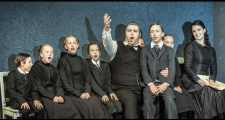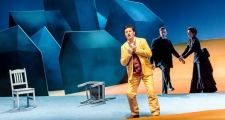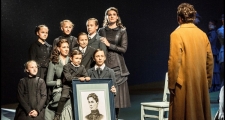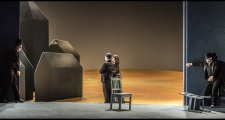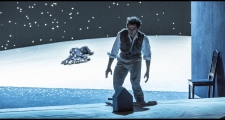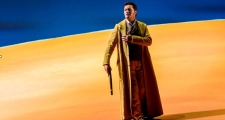Radosny kochanek i tragiczny samotnik
Piotr Beczała jako Werther w mistrzowskim spektaklu DeckeraSzedłem na premierę dramatu lirycznego "Werther" Jules'a Masseneta z radością, że wreszcie usłyszę na żywo Piotra Beczałę w tej roli, która towarzyszy mu od 25 lat, ale wchodziłem do Teatru Wielkiego – Opery Narodowej także z lekką obawą, że będę oglądać inscenizację, która krąży po Europie od dawna, a obecna wersja jest przeniesiona z Narodneho Divadla w Pradze. Moje obawy jednak szybko okazały się nieuzasadnione. Jest w tej warszawskiej premierze świeżość i są niesamowite emocje.
Kiedy rozsunęła się kurtyna, zobaczyłem świat, który wypada z ram. Unosząca się ku górze podłoga jest często wykorzystywana w teatrze, ale tutaj konstrukcja została przesunięta w lewo jak kubistyczna forma z krzywym sufitem, złowrogo wiszącym nad bohaterami. Miałem wrażenie, jakby ten sufit za chwilę miał spaść na nich, przygniatając ich do ziemi. Zwłaszcza w czwartym akcie to wnętrze przypominało mi wielki sarkofag, w którym Charlotte i Werther zaraz zostaną zamknięci na wieczność jak Romeo i Julia.
Wydobyć to, co najlepsze
„Werther" jest niewątpliwie jedną z najwspanialszych oper XIX wieku, ale nie każda orkiestra potrafi oddać piękno i dramatyzm tej muzyki. Patrick Fournillier, który objął od tego sezonu stanowisko dyrektora muzycznego Teatru Wielkiego – Opery Narodowej po Grzegorzu Nowaku, wniósł wiele dobrego. Świetnie poprowadził orkiestrę, z polotem i precyzją, z francuską delikatnością i subtelnością, a równocześnie tam, gdzie trzeba – z dramatyzmem i bogactwem brzmienia. Bezdyskusyjnie wydobył ze śpiewaków to, co najlepsze.
Piotr Beczała był od początku do końca spektaklu jego niekwestionowanym bohaterem. Chwilami śpiewał z niebywałą lekkością, a w dramatycznych momentach z wielką siłą emocji, jakby serce miało mu za chwilę pęknąć. Wspaniała była jego transformacja z radosnego kochanka w tragicznego samotnika. Kiedy pojawił się na scenie w słoneczny lipcowy dzień w żółtym garniturze i brązowej kamizelce, zachowywał się jak zakochany dwudziestolatek, śpiewając arię "O nature pleine de grâce" delikatnie i lekko, leżąc na podłodze. Chwilę potem zabiera Charlottę na bal, pełen pozytywnych emocji, jednak reżyser kazał mu trzymać rewolwer, który położył na ziemi. "Jeśli w pierwszym akcie powiesiłeś strzelbę na ścianie, to w następnym musi ona wystrzelić"- napisał kiedyś Antoni Czechow. I w końcu tak się stanie, ostatecznie.
Beczała pokazał więcej wokalnej elegancji i finezji podczas "O, spectacle idéal d'amour et d'innocence", wybuchając z intensywną namiętnością podczas "Rêve, extase". W II akcie Werther Beczały zamienił się z nieszczęśliwie zakochanego młodzieńca w zazdrosnego, wściekłego mężczyznę. To było najbardziej widoczne podczas poruszającego duetu z Charlotte, kiedy widzieliśmy delikatność pomieszaną ze złością i rozpaczą. To poczucie desperacji narastało w kolejnych aktach.
Słynna aria „Pourquoi me réveiller?" (Dlaczego mnie budzisz, o powiewie wiosny...) została zaśpiewana fenomenalnie, mimo iż Beczała został brutalnie zatrzymany w połowie przez owacje publiczności, co zakłóciło na chwilę atmosferę i wprawiło w zakłopotanie dyrygenta. Szkoda. Kiedy aria została zakończona, publiczność klaskała frenetycznie, krzycząc „Bis!". Byłem zawiedziony, że dyrektor muzyczny na to nie pozwolił. Może moglibyśmy tej arii wysłuchać tym razem od początku do końca... (Tak stało się w sobotę 10 października.) Było również imponujące to, że chwilami śpiewał trudną arię na kolanach lub na leżąco, a głos nadal brzmiał bez wysiłku.
Beczała potrafił po raz kolejny udowodnić, że może być obecnie uznany za najlepszego Werthera na świecie. Zaśpiewał też z nienaganną dykcją i precyzją francuskiej wymowy, która przecież ewidentnie nie jest łatwa.
W interpretacji Charlotty przez mezzosopranistkę Irinę Zhytynską zabrakło chwilami stabilności głosu. Jej vibrato sprawiało, że chwiejny głos nie przebijał się przez orkiestrę. Można by uznać vibrato za dramatycznie uzasadnione w płaczliwej arii "Va! Laisse couler mes larmes", kiedy żałuje, że nie wyszła za mąż za Werthera, ale rozpraszało podczas śpiewania "Il faut nous séparer" w I akcie, kiedy Charlotte i Werther mają delikatną wymianę zdań.
Finałowa scena z Wertherem była również nieco denerwująca. Zhytynska wykonywała za dużo nerwowych ruchów, by wyrazić swą desperację, ale wydawało się, że brakuje w tym spójności. Jej zachowanie i śpiew odwracały uwagę od subtelniejszego działania kolegów w scenie śmierci.
Natomiast znakomity wokalnie był Stanisław Kuflyuk jako Albert. Stworzył wyrazistą kreację silnego mężczyzny, który walczy o rodzinę i próbuje z wielkim trudem utrzymać harmonię, pozbywając się rywala. Był szczególnie przekonujący, gdy śpiewał arię "Elle m'aime" z delikatnością, którą w kolejnym akcie skontrastował z wokalną siłą. Jego głos brzmiał soczyście i wspaniale. Można się tylko przyczepić do jego niezbyt precyzyjnej francuskiej wymowy.
Sopranistka Sylwia Olszyńska również bardzo dobrze wcieliła się w Sophie. Śpiewała mocnym głosem, emanującym świeżością i żywiołowością.
Wizualne arcydzieło
Inscenizacja Willy'ego Deckera to wizualna uczta, pełna symboli i szczegółów, które pozwoliły na pełne zanurzenie się w świecie tej historii. W spektaklu Deckera świat jest symbolicznie pokazany w trzech kolorach: niebieskim, żółtym i białym (nawiązanie do powieści Goethego, który pokazuje tytułowego bohatera ubranego w błękitny frak i żółtą kamizelkę w finałowej scenie). Scenografia i kostiumy zaprojektowane przez Wolfganga Gussmanna skupiają się na 4 kolorach (granatowym, żółtym, czarnym i białym). W pierwszym i drugim akcie mamy niebieskie wnętrze domu z miniaturami budowli miasteczka i krzesłami. Za przesuwną ścianą domu jest otwarta przestrzeń do nieskończoności, z żółtą podłogą, przypominającą publiczności o letniej aurze. Ale skojarzeń jest tu więcej. Ubrany w piaskowy strój Piotr Beczała leży na żółtej podłodze z jednym kolanem uniesionym w górę. Sprawia wrażenie rozluźnionego i szczęśliwego, jakby leżał na słonecznej plaży. Ale nie wszystko jest słoneczne. Tragiczny Los zbliża się wielkimi krokami w tym spektaklu.
Pierwszym symbolem Fatum staje się obraz matki głównej bohaterki. Charlotte wchodzi z tym portretem w interakcję, gdy nie wisi on złowieszczo na ścianie.
Drugim symbolem Fatum są dwaj słudzy. To dziwaczne kreatury: jeden wysoki (Jasin Rammal-Rykala), drugi niski (Jacek Ornafa). Na początku przypominają trochę postacie z cyrku, zachowują się w sposób przerysowany jak w niemych filmach. Obaj panowie są ubrani w czarne fraki i mają na głowach cylindry. Przypominali mi braci Janickich z Teatru Śmierci Tadeusza Kantora, ale Europejczykom mogą też kojarzyć się z Vladimirem i Estragonem z „Czekając na Godota" Samuela Becketta. W pewnym momencie Estragon mówi: „A może by tak się powiesić?". Tutaj jednak to oni stają się personifikacjami złowrogiego Losu, który prowadzi Werthera do tragicznego końca. Znamienny jest na przykład moment, kiedy biorą jego rewolwer, a potem – pod koniec III aktu – przekazują go Wertherowi, aby wreszcie zakończyć tę historię.
Również warta zauważenia w wersji Deckera jest prostota strony wizualnej, pozwalająca na łatwiejsze wydobycie przeżyć wewnętrznych bohaterów. Scenografia nawiązuje do kubizmu, a proste, minimalistyczne modele budynków wewnątrz domu sprawiają wrażenie tekturowych zabawek. Jednak w momencie, gdy Werther chwyta domek, jeszcze bardziej dociera do nas potężny smutek spowodowany tym, że on nie ma już domu. Wszędzie czuje się nieszczęśliwy, ponieważ dom kojarzy mu się z zatrzymanym w pamięci obrazem Charlotty z jej młodszym rodzeństwem. Piękny jest w spektaklu moment, kiedy Charlotte ustawia się z dziećmi jak do pamiątkowego zdjęcia, a stojący naprzeciw niej Werther próbuje zatrzymać ten kadr w swojej pamięci.
Inny wyjątkowy moment w spektaklu pojawia się wraz z pierwszą sceną III aktu, kiedy Charlotte i Albert siedzą naprzeciw siebie przy stole długim prawie na całą szerokość sceny. Stół stoi tam po uczcie weselnej z II aktu. Charlotte kładzie jedną dłoń na blacie, a w lewej dłoni trzyma pożółkłe, ogromne kartki papieru z listami Werthera. Gdy w kolejnej scenie rozrzuca te listy po podłodze domu, jest w tym jakieś wielkie cierpienie i niekończąca się udręka. Kiedy w końcu zwraca się do Boga i drze listy, próbuje symbolicznie skończyć ze swoją miłością, ale kiedy pojawia się Werther, nagle uczucie powraca z niesamowitą siłą.
Ogólnie rzecz ujmując, to było fantastyczne przedstawienie, nie tylko dzięki znakomitemu występowi Piotra Beczały, ale również produkcja Deckera została wypełniona hipnotyzującymi efektami wizualnymi.
__
Polish National Opera 2020-21 Review: Werther
Piotr Beczała Reigns Supreme in Willy Decker's Masterful Production
As I was going to the first performance of "Werther," a drame lyrique by Jules Massenet, I was glad that I would finally listen to Piotr Beczała live in this role, which he has performed for 25 years.
Nevertheless, as I entered Teatr Wielki – the Polish National Opera, I was also a bit concerned that I was about to watch a production that had been touring Europe for a long time and whose current version was adopted from Narodni Divadlo in Prague. It quickly turned out that my worries were unsubstantiated. The Warsaw premiere was filled with freshness and incredible emotions.
When the curtain parted, I saw a world that coming out of the box. A raised floor is often used at the theatre, but here the whole structure was shifted to the left like a cubist construction with a lopsided ceiling that ominously hung over the characters. I felt as if the ceiling would soon fall on them, crushing them to the ground. Especially in Act four, the interior reminded me of a large sarcophagus, in which Charlotte and Werther would be locked forever, just like Romeo and Juliet.
Bring out the Best
Werther is undoubtedly one of the grandest operas of the 19th century, but not every orchestra can convey the beauty and drama of this music. Patrick Fournillier, who assumed the position of Director of The Polish National Opera after Grzegorz Nowak, has brought a lot of value. He led the orchestra with charm and precision, with French finesse and subtlety, and with dramatic tension and the richness of sound where necessary. He undisputedly brought out the best in the singers.
Piotr Beczała was an unquestionable hero from the beginning to the end of the performance. At times he sang with an unbelievable lightness and at dramatic moments with strong emotion as if his heart was about to burst. His transformation from a cheerful lover into a tragic hermit was wonderful. When he appeared on stage on a sunny day in July wearing a yellow suit and a brown waistcoat, he acted like a 20-year-old in love, singing the aria "O nature pleine de grâce" (O, Nature, full of grace) in a delicate manner while lying on the ground.
Soon thereafter, he takes Charlotte to the ball, full of positive emotion, yet the director made him hold a gun which he laid on the ground. "If in the first act you have hung a pistol on the wall, then in the following one it should be fired," Anton Chekhov once wrote. And so it would come to pass, eventually.
Beczała exhibited more vocal finesse and elegance during "O, spectacle idéal d'amour et d'innocence" erupting into an intense passion on "Rêve! Extase!"
In the second Act, Beczała's Werther transformed from an unhappy young lover to a jealous, enraged man. This was most visible during the moving duet with Charlotte as we saw gentleness mixed with anger and despair. This sense of desperation only built up in the ensuing acts.
The famous aria "Pourquoi me réveiller?" was sung phenomenally, even though Beczała was brutally interrupted halfway by an ovation from the audience, which disrupted the atmosphere for a moment and embarrassed the conductor. It was a pity. After the aria concluded, the audience clapped frantically and demanded "Encore!" I was disappointed that the music director did not allow it. Perhaps this time we would be able to listen to the aria from beginning to end... (Which was the case on Saturday, October 10). What was also impressive was that at times he sang this difficult aria on his knees or lying down and it still sounded effortless.
Beczała managed to prove yet again that he can be considered the best Werther in the world. He sang with flawless elocution and the precision of the French pronunciation which evidently isn't easy.
Mezzo-soprano Irina Zhytynska's interpretation of Charlotte lacked in vocal stability throughout. Her vibrato tended to be rather wobbly and she was often overpowered by the orchestra. One could argue that the wide vibrato was dramatically justified in the tearful "Va! Laisse couler mes larmes," when she wishes she had married Werther, but it felt distracting in the first act's "Il faut nous séparer" when Charlotte and Werther engage in a gentle exchange.
The final scene with Werther was also frustrating. Zythynska relied heavily on too many physical gestures to express her desperation, but it too seemed lacking in cohesion and sense of direction. As with her wobbly vibrato in the first Act, her constant movement distracted from her colleague's more subtle approach in the death scene.
On the other hand, Stanisław Kuflyuk was outstanding as Albert. His interpretation portrayed a strong, powerful man fighting for his family and struggling to maintain harmony while getting rid of his rival. He was especially convincing when he delivered the aria "Ell m'aime" with finesse before nicely contrasting it with vocal potency in the ensuing act, his voice lush and glorious in its sound. Perhaps the only element of his performance that was lacking was his French pronunciation, which was overly imprecise.
Soprano Sylwia Olszyńska also delivered a solid performance as Sophie. She sang with a strong sound that emitted freshness and vibrancy.
Visual Masterwork
Willy Decker's production was a visual feast full of symbols and details that allowed for deep immersion in the world of this story.
In Decker's spectacle, the world is symbolically shown in three colors: blue, yellow, and white (a reference to Goethe's novel where he presents the title character dressed in a blue frock coat and a yellow vest during the final scene) while the stage scenery and costumes, designed by Wolfgang Gussmann, are based on four colors (navy blue. yellow, black, and white). In Act one and two, the interior of the house is blue, with miniature town buildings and chairs. Behind a sliding wall of the house, there is infinite open space with a yellow floor, which reminds the audience of summertime. But there are more associations. Piotr Beczała, dressed in a sandy suit, lies on the yellow floor with one knee raised in the air. He seems relaxed and happy as if he was lying on a sunny beach.
But not all is sunny. Fate looms large throughout the production.
The first symbol of Fate is an image of Charlotte's mother. Character constantly interact with it when it isn't hanging ominously on the wall.
The second symbol of the Fate comes in the form of two servants. They are strange creatures, one tall (Jasin Rammal-Rykala) and the other short (Jacek Ornafa). In the beginning, they look like characters from the circus and behave in an exaggerated manner, like in silent films. Both wear black tail-coats and top hats. They reminded me of the Janicki brothers from Tadeusz Kantor's Theatre of Death, but Europeans may associate them with Vladimir and Estragon from "Waiting for Godot" by Samuel Beckett. At some point, Estragon says: "What about hanging ourselves?" But here they are the embodiment of ominous Fate, which leads Werther to his tragic end. A striking moment is when they take his revolver and then, at the end of Act 3, give it to Werther to finally put an end to this story.
Also worthy of note in Decker's version is the simplicity of its visual approach, allowing for a clearer exploration of the characters' inner life. The stage design draws on cubism, whereas simple and minimalistic models of buildings inside the house look like cardboard toys. But when Werther grabs such a building, what becomes even more striking is the enormous sadness caused by the fact that he no longer has a home. He feels unhappy everywhere because he associates home with the image of Charlotte and her younger siblings. There is a beautiful moment when Charlotte and the children pose as if for a souvenir photo, a snapshot Werther tries to cling to.
Another special moment comes in the first scene of Act three, when Charlotte and Albert are seated at a table almost as long as the stage, facing each other from opposite ends. The table stays there after the wedding reception in Act two. Charlotte lies one hand on the top of the table and in her left hand she is holding huge yellow pieces of paper with Werther's letters. When she scatters these letters on the floor in the next scene, it shows her great suffering and endless torment. As she finally addresses God and tears up the letters, it symbolizes her attempt to put an end to her love, but when Werther appears, the feeling suddenly comes back with overwhelming strength.
Overall, this was a fantastic performance featuring not only a heroic turn from Piotr Beczała but a production by Decker filled with a mesmerizing visual style.
___
By Krzysztof Korwin-Piotrowski
Krzysztof Korwin-Piotrowski – a journalist, theatrologist, culture manager, television and theatre director, music commentator, art director of Bogusław Kaczyński Orfeo Foundation in Warsaw, editor-in-chief of the ORFEO music website and the creator of the Ofreo.TV Internet television, lecturer at the Faculty of Artes Liberales of the University of Warsaw, winner of film awards and the Gloria Artis medal awarded by the Minister of Culture and National Heritage.


